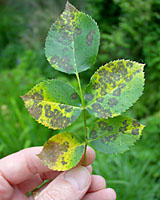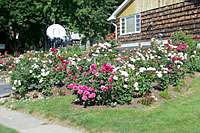Terry L. Ettinger Horticulture Consulting Services
Meeting The Needs Of Today With A Vision For The Future
Question of the Week
Rose Black Spot
 Q. My wife planted a small rose garden (15 plants) for me as a birthday present two years ago. They did very well last year despite the
drought. This year, however, I’m afraid most of the plants are dying from what I’m pretty sure is black spot disease. What can I do to
save these plants?
Q. My wife planted a small rose garden (15 plants) for me as a birthday present two years ago. They did very well last year despite the
drought. This year, however, I’m afraid most of the plants are dying from what I’m pretty sure is black spot disease. What can I do to
save these plants?
A. Cool, damp weather in April and early May provides ideal conditions for a number of “leaf spot” diseases to infect a wide variety of trees, shrubs and other garden plants. The most common leaf spot disease of roses that thrives in damp spring weather, for example, is black spot.
Black spot of roses overwinters as lesions on infected leaves and canes. Spores are released from the lesions as temperatures rise in the spring, then germinate and infect young leaves that remain wet for several days as they begin to expand in late April and early May. New infections continue to occur throughout the growing season whenever leaves remain wet for extended periods of time. This often results in severely infected roses losing all of their leaves by late summer.
 The first step in managing black spot is to plant roses at least three to four feet apart in well-drained soils where they’ll
receive full sun all day long. This will help foliage dry as quickly
as possible after rainfall or heavy due, thus reducing the window of
opportunity for black spot spores to germinate and infect tender
leaves.
The first step in managing black spot is to plant roses at least three to four feet apart in well-drained soils where they’ll
receive full sun all day long. This will help foliage dry as quickly
as possible after rainfall or heavy due, thus reducing the window of
opportunity for black spot spores to germinate and infect tender
leaves.
The next step in black spot management is to rake up all the leaves from beneath your roses as soon as the snow melts, prune back all winterkilled and unthrifty canes to healthy wood and pull off any leaves that remain after you’ve finished pruning the canes. These three steps will eliminate many of the lesions that can release early-season spores. Picking off infected leaves as soon as they appear in May and June will also reduce the number of spores available to cause new infections during the growing season.
The final step in managing black spot is to apply fungicides containing chlorothalonil (Daconil), mancozeb (Dithane, etc.), copper (Kocide), or triforine (Funginex) according to label directions every seven to ten days as soon as the leaves begin to expand in the spring.
However, remember that if you try to grow roses under less than ideal conditions of full sun, good air circulation and evenly moist, well-drained soils, no amount of fungicides will keep black spot at bay.
One last thought regarding black spot.
My preference is always to recommend pest resistant plants whenever possible. Unfortunately, what researchers are discovering is that the resistance of roses to black spot is quite variable depending upon growing conditions and the specific genetic strain(s) of the black spot fungus that may be active in a given garden. You can read more about the complexities of black spot resistance at the Purdue Plant & Pest Diagnostic Laboratory website.